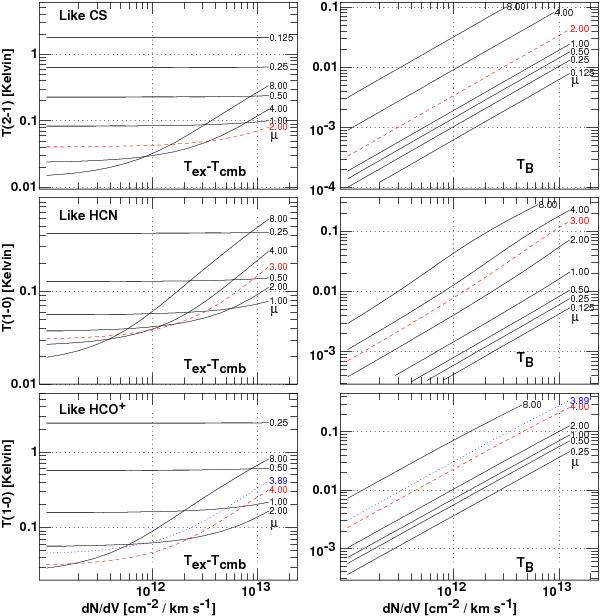Fig. 3

Dependence of the rotational excitation upon permanent dipole moment μ (Debye) at n(H) = 2n(H2) = 256 cm-3, TK= 35 K and xe = 1.4 × 10-4 as before. The horizontal axis is column density per unit velocity and vertical axes are line excitation temperatures (at left) and brightness temperatures (at right) above the cosmic background. The CS-like species at top has the same rotational energy spacing and H2-excitation rates as CS, but the dipole moment is varied wherever it appears analytically in expressions for the line optical depth, brightness etc. and electron-neutral molecule excitation rates. Panels in the middle row are for the strongest hyperfine component of the J = 1−0 line of a neutral HCN analog, and the lowest two panels in each column pertain to the J = 1−0 line of a molecular ion analog of HCO+ (compare with Fig. 1). In each row one series of calculations is shown by red dotted lines; by coincidence those use values very close to the actual dipole moments of CS (1.96 D), HCN (2.98 D) and HCO+ (3.89 D). The dotted blue curve in each of the lowest two panels uses the correct dipole moment and the recent electron excitation rates of Faure et al. (2007a).
Current usage metrics show cumulative count of Article Views (full-text article views including HTML views, PDF and ePub downloads, according to the available data) and Abstracts Views on Vision4Press platform.
Data correspond to usage on the plateform after 2015. The current usage metrics is available 48-96 hours after online publication and is updated daily on week days.
Initial download of the metrics may take a while.


